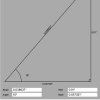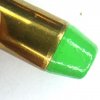I do agree that not going tighter than needed is a good plan. The gun I checked is a Colt Gold Cup, so I
am sure that it is entirely possible that other manufacturers have used different tolerances and dimensions
in some areas. One of the issues with the 1911 platform is that if a new company decides to change
key dimensions "to make it better", JMB gets the blame if it doesn't work. It is key to know that
the FP will never, ever fail to reach any primer.

Anyone who hasn't pushed in the FP with
a pin punch will be surprised by that (if the FP lock is disengaged, if it has one). So, maybe some
1911s might have a tight enough extractor to come into play. I need to repeat this on non-Colt
guns and see if that is the difference.
I have done some relatively recent accuracy testing with different crimp tightnesses. With hard
commercial H&G 68s in making IPSC ammo, function was what was important, guilt edged
accy wasn't anywhere near as important. With my softer bullets (WW+tin) I can just detect a slight
drop in accy between .464-.465 and .468ish TC. Small, but I was able to replicate it. So, for my
match ammo, I use my own cast real H&G 68s, or my wonderful LBT copy, or the equally wonderful
MP Products copy and .467-.468 TC in only Rem brass with Fed primers, 4.4 gr TG. For all other purposes,
commercial cast H&G 68 clones, range brass, any primer, usually CCI300, and 4.8 TG, and .465
TC for best possible reliability. I have been able to repeatedly get better groups with Rem
brass than with any other brand, to my surprise. Even brand new, wonderful Starline could not
match the groups. No idea why. Nothing that I can measure shows up.
I will readily admit that a very tight TC can reduce max accuracy, in certain situations, but it is a
small effect. Lack of TC or inadequate TC has a large effect on feeding realibility.
And in the end, what is really important is fitting YOUR ammo to YOUR gun. I can tell you what
has worked for a whole lot of different folks making high-reliability IPSC ammo for many guns,
mostly Colts in those days, but that is no guarantee in any particular gun. And most new 1911s these
days come with quite a bit tighter chambers and shorter throats than was the situation when
all 1911s
had a horse on the side.
I, too, have found .4515 to be the best spot for .45ACP. I often wind up .001 to .003 over groove
diameter in other guns/cartridges, but it does not work in .45 ACPs. Even my huge throated M1917s (Colt and
S&W) will not chamber larger than .454. The semiautos might work with fatter bullets deep seated,
but not a good thing.
Bill




